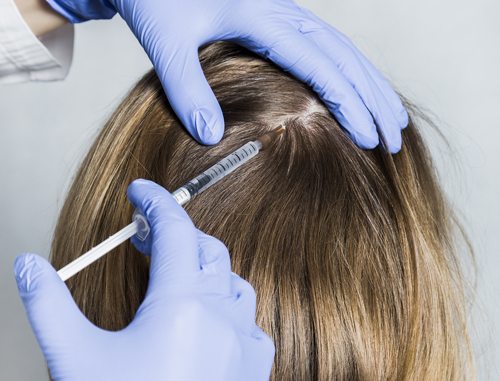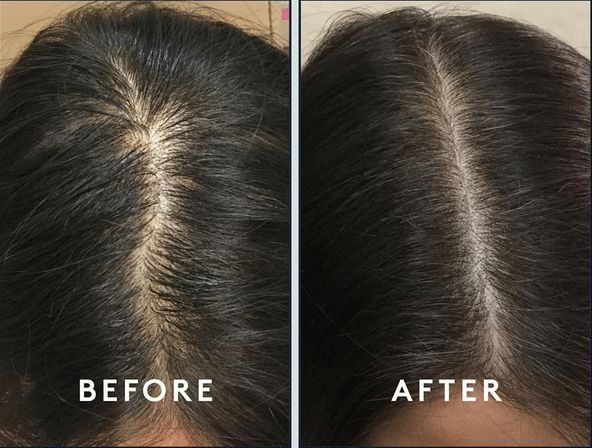PRP & Exosome Hair Restoration Phoenix
Are you struggling with hair loss that affects your confidence? At Suddenly Slimmer Med Spa Phoenix, we offer cutting-edge treatments that address the root causes of hair loss. Our innovative solutions, including PRP and Exosome Therapy, are designed to help restore your hair. We invite patients in Phoenix to experience our personalized and comprehensive treatment plans tailored to your needs.
LIMITED TIME: $100 OFF 1st treatment!
Have Question? Call us 602-952-8446
“Identifying the underlying cause of each individual’s hair loss is essential for effective hair regrowth.” ~Dannielli RN ~
Platelet-rich plasma (PRP) is a unique hair loss treatment that utilizes the growth factors in your blood to stimulate new hair growth and prevent further hair loss. Many of us struggle with hair loss today. In fact, according to the International Society of Hair Restoration Surgery, approximately 56 million adults in the United States are affected by some type of hair loss. Up until recently, few non-surgical treatments were available for hair restoration. However, with a short series of PRP injections, patients can achieve thicker, fuller, healthier hair that lasts. Suddenly Slimmer Med Spa medical professionals are experts in cosmetic and PRP hair restoration and has been at the forefront of helping patients regrow hair via PRP & Exosome Therapy injections or MicroNeedling.
Platelet-rich plasma (PRP) and Exosome Therapy have emerged as popular regenerative treatments. While microneedling with PRP and Exosome Therapy is well-known for facial rejuvenation, their applications extend far beyond that. These therapies are increasingly sought after for hair restoration, effectively enhancing hair density while reducing thinning and shedding.
The process involves extracting platelet-rich plasma from the patient’s own blood, while exosomes, which contain growth factors and signaling molecules, help stimulate hair follicle growth and improve scalp health. Once isolated, PRP and Exosome are injected strategically to areas of the scalp impacted by hair loss or thinning. This treatment not only triggers natural hair growth but also fortifies hair follicles, supporting regrowth and preventing further loss.
The procedure is straightforward, requiring minimal downtime and discomfort, making it an excellent choice for patients who are hesitant about surgical interventions, such as hair transplants.
Suddenly Slimmer Med Spa boasts a team of medical professionals with over 30 years of experience, renowned for providing the highest quality non-surgical cosmetic treatments to some of the world’s most discerning clients. Their offerings include advanced options such as platelet-rich plasma and Exosome Therapy for hair restoration. Adopting a holistic approach, they tailor each treatment plan to meet the unique needs and goals of every patient. Consistently recognized as one of Phoenix’s top doctors, the licensed professionals at Suddenly Slimmer Med Spa are dedicated to patient care and expertise. During your consultation, they will work with you to create a personalized hair loss treatment plan designed to enhance your hair’s health and thickness, ensuring lasting results.

Hair Loss
Hair loss is a common issue that impacts both men and women, with the American Academy of Dermatology reporting that over 80 million Americans experience thinning or loss of hair. This condition can arise from various factors including genetics, hormonal fluctuations, aging, certain medications, underlying health conditions, styling practices, and illness.
To effectively address your hair loss, consulting one of our licensed medical professionals is key to identifying the specific factors at play. At Suddenly Slimmer Med Spa, we create personalized treatment plans based on each patient’s medical and family history, along with a thorough assessment of the scalp and hair, as well as any previous treatments they may have tried.
Androgenic alopecia, commonly known as male-pattern or female-pattern hair loss, is the most prevalent type and is primarily hereditary. In this condition, the anagen (growth) phase shortens, leading to progressively thinner hair strands. The term “androgenic alopecia” reflects its genetic sensitivity to androgen hormones at the hair follicle level. This hereditary hair loss typically becomes more pronounced with age and follows a predictable pattern. Male pattern baldness often manifests as a thinning crown and receding hairline forming an “M” shape, while female-pattern baldness usually appears as diffuse thinning and a widening hairline. Although androgenic alopecia cannot be completely prevented, its progression can be delayed, and hair restoration can be promoted through various treatment options available at Suddenly Slimmer Med Spa in Phoenix.
For optimal results, hair loss treatment is often most effective when employing a customized, multi-faceted approach. Depending on the type of hair loss you are experiencing, Suddenly Slimmer Med Spa may recommend a tailored combination of prescription medications, including oral or topical minoxidil (Rogaine), Finasteride (Propecia), or PRP and Exosome Therapy injections. Additionally, certain lifestyle adjustments, such as increasing vitamin intake (like biotin) and enhancing your hair care regimen, can contribute to stronger, healthier hair. With over 30 years of experience providing discerning individuals with top-tier non-invasive treatment options, the medical professionals at Suddenly Slimmer Med Spa Phoenix are dedicated to helping you achieve thicker, fuller, and healthier hair that lasts.
What is Platelet-Rich Plasma (PRP)?
Platelet-rich plasma is a concentration of platelets three times the standard blood value and contains many growth factors that stimulate hair follicles. PRP is derived from a sample of the patient’s own blood and injected into different areas of the scalp to promote hair growth. The treatment can safely be performed monthly, based on how much hair growth is required. PRP is an excellent solution for treating hair loss in both men and women, especially when hair transplant surgery is not viable. PRP injections can stimulate new hair growth in men who suffer from androgenetic alopecia (known as male pattern baldness) and women who suffer from female pattern baldness. In addition to treating hair loss and thinning hair, PRP is also commonly used to treat joint injuries and in many other cosmetic facial skin rejuvenation and microneedling treatments.
Platelet-rich plasma contains eight different growth factors, several of which are associated with hair restoration. These growth factors include fibronectin, platelet-derived growth factor (PDGF), epidermal growth factor (EGF), platelet-derived angiogenesis factor (PDAF), vascular endothelial growth factor (VEGF), insulin-like growth factor (IGF), and transforming growth factor (TGF). The growth factors most relevant to hair regrowth include fibroblast growth factor, vascular endothelial growth factor, platelet-derived growth factor, and epidermal growth factor. In the healing process, growth factors play a role in cellular differentiation, proliferation, migration, and morphogenesis. VEGF plays a role in creating blood vessels and other cells and tissues required for hair growth. PDGF also contributes to creating the required cells and helps prolong the anagen phase of hair growth, which can also prevent further hair loss. FGF also stimulates and prolongs the anagen phase. EGF is associated with developing hair follicles and stimulating the anagen phase of hair growth. By injecting all of these growth factors into areas of the scalp affected by hair loss or thinning, it is possible to restore thicker, fuller, healthier hair.

Non-invasive hair restoration treatments
Until recently, the only non-surgical hair growth or restoration solutions were topical treatments like minoxidil (Rogaine) or oral medications like Finasteride (Propecia). There are many benefits associated with such hair loss treatment options, and for many individuals with hair loss, topical and oral interventions are integral components of their hair loss treatment plans. Some patients seek other treatment options because they are frustrated by the constant upkeep, potential unpleasant side effects, or inconsistent results from topical and oral treatments. Though oral medications and topical treatments are effective against hair loss and can be a sufficient solution on their own for some, many patients dealing with male-pattern hair loss can deal with side effects (such as erectile dysfunction). Additionally, patients coping with female-pattern hair loss are often either contraindicated for or uninterested in taking hormonal or anti-androgenic therapies. Other patients seek additional treatment options to maximize their hair restoration results using supplemental treatment modalities.
PRP therapy for hair growth has become an innovative treatment option for patients dealing with androgenic alopecia (male-pattern hair loss) and female-pattern hair loss and thinning hair along the top of the head. Platelet-rich plasma has been proven an effective regenerative treatment for many health and wellness concerns, from orthopedics to endodontics to dermatology. PRP hair restoration is a safe, natural, and simple way to improve hair growth without invasive surgery or downtime. PRP injections can safely be used with other topical and oral treatment options to optimize hair restoration results for thicker, healthier-looking hair.
What is PRP Treatment for Hair Loss?
Platelet-rich plasma (PRP) injections have become a popular non-surgical solution for hair loss restoration in both women and men. This innovative treatment utilizes autologous PRP, meaning it harnesses a sample of the patient’s own blood. After a blood draw, the sample is processed in a centrifuge to separate the plasma from other blood components, such as red blood cells. The resulting plasma is then injected into specific areas of the scalp experiencing hair loss or thinning.
This concentrated platelet-rich plasma is abundant in beneficial white blood cells and growth factors, which play a crucial role in enhancing the health of hair follicles and stimulating new hair growth. When injected into areas affected by hair loss or excessive shedding, PRP improves blood supply to the follicles and activates reparative cells, promoting a healthier scalp environment.
For patients who may be sensitive to the PRP injections, we apply a topical anesthetic to the scalp 15-30 minutes prior to the procedure to minimize any potential discomfort. The entire process, from blood draw to PRP injection, takes about 30 minutes, and there is no downtime required afterward.
To achieve optimal restoration results, an initial series of PRP treatments is recommended, typically consisting of four sessions spaced one month apart. Following this series, many patients opt for semi-annual maintenance treatments to sustain their hair restoration results.
What types of hair loss does PRP therapy help?
PRP Treatment is effective in increasing hair growth and hair density. Still, treating certain conditions, including Androgenic Alopecia, Telogen Efflux, and alopecia areata, works best in females and males.
Female and Male Androgenic Alopecia – Androgenic alopecia can affect both men and women and is related to fluctuations in the androgen hormones, specifically dihydrotestosterone. While the condition can affect both men and women, it manifests differently. For men, the disease is characterized by what is sometimes referred to as “male pattern baldness,” meaning hair loss that starts at the temples, creating the hairline’s common “M” shape. Hair loss will then continue along the crown of the head. For women, the condition manifests typically in thinning hair on the top of the head, along the height; it usually looks like the part of the hair is getting wider as the hair loss occurs.
The condition’s cause is still largely unknown, but researchers believe it is related to the expression of the AR gene. While treating the cause or addressing the risk factors is impossible, as they are not known, PRP treatment works well to promote hair growth in affected areas. It can be combined with topical medications, such as minoxidil and Finasteride.
Telogen Effluvium – Telogen Effluvium is a stress-related hair loss condition and can be acute, meaning the hair loss occurs at once, or chronic, meaning the thinning occurs repeatedly over time. Effluvium is defined as the resting stage of the cycle of hair growth, and when a traumatic event occurs, hair can be forced into the resting phase, or vapor, prematurely. The shedding phase follows the resting step, and if a significant amount of hair is moved into the resting phase early, a higher-than-normal amount of hair will be lost at once. Many different traumatic events can cause stress on the body and activate the Telogen effluvium condition, including extreme illness, childbirth, severe chronic illness, surgery, psychological trauma or anxiety, and diets that do not contain sufficient protein or medications.
Typically, this kind of hair loss affects the scalp, but hair loss can occur anywhere on the body. In most cases, after the hair has fallen out, regrowth will occur over the next three to six months. PRP is a great treatment to help with regrowth, speed up rejuvenation, and ensure that hair grows densely and healthy.
Alopecia Areata – Alopecia areata is an auto-immune condition, meaning that the body’s immune system erroneously attacks itself, characterized by patchy scalp hair loss. Patients who suffer from alopecia areata have white blood cells that attack their hair follicles, causing the brainless to shrink in size and slow down hair growth. Hair may fall out in quarter-sized patches, and the hair loss can be limited to only a few lost patches of hair to more severe cases with a significant amount of hair loss. The condition is believed to have a genetic link and can occur suddenly, affecting people of any age and gender.
There is no known cure for alopecia areata, but many patients who experience it have full hair regrowth in 12 months. PRP therapy can be used during this regrowth process to help boost hair rejuvenation and encourage growth.
What are the benefits of PRP therapy?
The platelets in the PRP contain proteins needed to accelerate the tissue healing and regeneration rate within inactive hair follicles. Inside these platelets are a variety of intracellular structures such as glycogen (a form of glucose), lysosomes (which break down the proteins), and alpha granules (which contain clotting and growth factors that get released during the cell repair process). Platelet-rich plasma-derived growth factors can also play a part in stem cell differentiation within the wound-healing process of the musculoskeletal system.
In particular, the PRP-specific cells that cause hair growth include:
- Factor (PDGF): for blood vessel, cell, and skin formation
- Vascular Endothelial Growth Factor (VEGF): For blood vessel formation
- Transforming Growth-Factor-Beta (TGF-b): For a growth matrix between cells, bone metabolism
- Epidermal Growth Factor (EGF): Cell growth, collagen and blood vessel formation
- Fibroblast Growth Factor-2 (FGF-2): Blood vessel and specialized cell growth
- Insulin-Like Growth Factor-1 (IGF-1): Also known as Somatomedin C, a protein regulator of normal physiology in nearly every type of cell in the body and has effects in adults
PRP is a very modern procedure used in medicine to heal injuries. It is often also used as a cosmetic facial treatment and a popular hair restoration procedure for men and women.
Do PRP injections work for hair loss?
Multiple studies through the Journal of Cosmetic Dermatology and Aesthetic Plastic Surgery found that patients suffering from hair loss benefit from PRP injections. The PRP hair restoration treatment led to a significant local increase in hair follicle number, extended growth phase, and improved hair thickness. Though the treatment is not officially FDA-approved, the equipment to prepare PRP is, and there is scientific proof that the treatment promotes greater hair strength and new hair growth at and around a PRP injection site.
The science behind PRP uses the proven benefits of autologous growth factors to promote new cellular growth naturally; PRP is directly involved in regenerative healing within the body. PRP growth factors can thus influence hair growth and restore hair follicles, improving the look and feel of a patient’s hair.
How does PRP hair restoration work?
PRP hair rejuvenation treatment involves the injection of platelets into the areas of the scalp where hair loss occurs, such as the crown of the head. Platelets are taken from the patient’s body via a blood draw that appears at the start of the appointment. After the blood has been drawn, it is placed in a centrifuge, a machine separating the platelet-rich plasma from the red blood cells. When isolated, the platelet-rich plasma is then injected into the treatment area. The platelets release growth factors that stimulate the dermal papilla cells, crucial in hair growth. Therefore, PRP injections help trigger hair regrowth to restore lost hair.
How many PRP treatment sessions are needed?
The number of recommended PRP treatments varies based on each patient’s hair condition and aesthetic goals, but a typical patient usually undergoes four sessions of PRP therapy. Further treatments will be assessed at the end of the fourth month, following the third session. These sessions are generally scheduled 4-6 weeks apart, and all hair loss consultations and PRP injections are administered by our licensed medical professionals. Additionally, PRP treatments can be combined with hair transplantation to promote faster hair growth. During your initial consultation, you can explore all available hair treatment options, including PRP injections. We are committed to leveraging our expertise to offer the best medical advice, diagnosis, and treatment for hair loss.
Does PRP hair treatment work for frontal hair loss?
Recent studies published in Dermatologic Surgery and the International Journal of Women’s Dermatology have demonstrated that PRP (Platelet-Rich Plasma) is an effective treatment for hair loss. This treatment has shown positive results in patients suffering from both androgenetic alopecia and alopecia areata, the latter characterized by unpredictable patchy hair loss across the scalp. Supporting evidence from additional research in the Journal of Cosmetic Dermatology, Aesthetic Plastic Surgery, and Men’s Journal further confirms that PRP is a valuable solution for promoting hair growth across the entire scalp.
How much is PRP hair treatment?
The cost of PRP treatment can vary significantly based on several factors, including the patient’s individual needs and goals, the experience of the treating physician, and the geographic location of the dermatology office. The total expense for your hair loss treatment plan will also depend on the number of PRP sessions required. Typically, patients begin with an initial series of four PRP sessions, each scheduled one month apart. During your initial consultation, our medical professional will work with you to create a hair restoration treatment plan that aligns with both your needs and budget.
Is PRP for hair loss covered by insurance?
No. PRP hair restoration is considered a cosmetic procedure, and PRP for hair loss is not typically covered by health insurance. If you would like more information, please contact your insurance company directly to determine the best coverage.
What to expect after PRP hair treatment?
After PRP treatment, downtime is minimal, allowing patients to quickly resume their normal activities. However, there are specific recommendations to follow in the days immediately after treatment to ensure optimal healing.
Firstly, patients should avoid washing their hair on the day of the treatment, but can resume using shampoo the following day. Secondly, we advise against exercising the day after the procedure, though regular workouts can be resumed the next day. Lastly, it’s important to refrain from alcohol and smoking for at least two days post-treatment.
At Suddenly Slimmer Med Spa Phoenix, we will provide you with essential aftercare information to help you achieve the best results from your hair restoration treatment.
How long does it take to see results from PRP hair loss treatment?
During their initial consultation, many patients express curiosity about the speed at which PRP treatment works for hair loss. Results can vary based on the specific type of hair loss and each patient’s individual goals. However, most patients notice an increase in hair thickness and growth just a few weeks after treatment. Typically, the most optimal results from PRP injections become evident around 5 to 6 months post-treatment.
How Long Does PRP Hair Treatment Last?
PRP hair treatment offers patients long-lasting results, though it may not serve as a permanent solution for all forms of hair loss. Most patients continue with maintenance sessions of PRP injections after their initial series to achieve optimal outcomes.
Is PRP hair treatment a permanent solution?
PRP treatment can be repeated as necessary, depending on the patient’s response to treatment. We may recommend that patients return every 3-4 months for another series of injections or even one maintenance treatment a year. The permanence of the treatment also depends on the condition being treated. For example, if a patient suffers from telogen effluvium, PRP treatment can help the hair regrowth process over 3-6 months. After that, most patients will not need any further treatment if the condition has subsided.
What are the side effects of PRP Treatment?
The most common side effects of hair restoration include swelling and tenderness at or near the injection sites in the treated area. These side effects tend to resolve independently within several days of treatment. Patients are advised to use Tylenol for pain relief before and after PRP treatment as opposed to Ibuprofen, Motrin, Advil, and Aleve, which are blood thinners and can cause increased oozing during treatment and exacerbate swelling afterward. Since Platelet-Rich Plasma is derived from the patient’s blood, there is no potential for an allergic reaction.
PRP has been used to restore skin and tissue in patients for several years. However, the hair restoration procedure is relatively new. The published studies that have reported improvement in hair growth show that recovery from all systems is easily tolerated. Common side effects include mild soreness and discomfort at the injection sites. Additionally, patients on any kind of blood thinner cannot undergo PRP treatment.
There is essentially no downtime required post-treatment, but we recommend patients avoid exercise the day of, and any alcohol consumption or smoking should be avoided for at least three days. It’s also best to wait a full day before washing your hair post-treatment. Before starting the treatment, all previous medical history should be discussed, and a full assessment of the nature of the hair loss should occur to ensure the best possible outcome from PRP treatment. When you have PRP injections, you will receive a list of aftercare advisements to ensure optimal results.
Are PRP injections painful?
PRP hair treatment involves injecting platelet-rich plasma directly into the scalp in areas affected by hair loss. Although the injections are performed swiftly by an expert, the scalp can be sensitive. To reduce any potential discomfort during the procedure, a topical numbing cream can be applied beforehand. After the treatment, patients may experience mild soreness, redness, or bruising at the injection site; however, these side effects are common and typically resolve quickly.
Can PRP make hair loss worse?
Not every patient is an ideal candidate for PRP hair restoration. Therefore, it’s crucial to discuss your medical history and have your current hair loss evaluated by our medical professionals during your initial consultation. In rare instances, patients may experience telogen effluvium, a temporary condition characterized by hair thinning due to shock, following an initial PRP injection. Fortunately, this effect typically resolves after the first treatment. If you have a history of scarring alopecia, PRP injections may not be the most suitable option for promoting hair growth.
Can PRP cause hair loss?
Some patients may not respond positively to PRP treatment, making it essential to disclose your medical history during the consultation before undergoing the procedure. Those with a history of scarring alopecia might not be suitable candidates for PRP, and in some cases, the treatment may even result in increased hair loss.
Will PRP stop hair loss? When will hair loss stop after PRP?
One of the first observable benefits of PRP is often a decrease in the amount of shedding occurring. Many patients observe this effect after just two PRP treatment sessions. Platelet-rich plasma therapy triggers and maintains natural hair growth by strengthening the hair follicle and increasing the thickness of the hair shaft. As such, in addition to promoting hair growth, the treatment helps stop future hair loss in the treatment area. Multiple treatments may be required to see optimal results.
Will PRP regrow hair?
PRP Treatment can be very helpful in the hair regrowth process. Injections of PRP into the treatment area can lead to an elongated hair growth phase and thickening of the hair shaft for thick, dense hair. For patients who have experienced hair loss due to conditions such as androgenic alopecia, telogen effluvium, or alopecia areata, PRP treatment can help strengthen hair and promote further growth during the regrowing process.





